Factual and Fictitious
Open Work as a Tool for Speculation
Spring 2020
Columbia University, GSAPP
Critic / Enrique Walker
Seminar / Open Work
Investigation / semantics of open work
︎
Once we’ve made sense of our world
We wanna go fuck (sorry) up everybody else’s
Because his or her truth doesn’t match mine
But this is the problem
Truth is individual calculation
Which means because we all have different perspectives
There isn’t one singular truth, is there? 1
To The Bone,
Steven Wilson, 2017
Steven Wilson, 2017
In the Poetics of the Open Work, Umberto Eco, though circumventing architectural referencing and correlations, spends time on excavating and disambiguating ‘meaning’ in openwork. He stitches the argument through a plethora of terms and synonyms which, perhaps brings forward the open-endedness of the describing open work. Towards the middle of the text, he attempts to link multiple facets of meaning in open work ranging from permutations, truths, prescriptions, freedom, interpretation indefiniteness, metaphors, and incompleteness. What is interesting is the last two lines – “In Short, it is an “open” situation, in movement. A work in progress.”2 Even after a detailed set of analogies, references, and interpretations, he chooses to leave the poetics of the open work as speculation in itself; a ‘movement’ that is not definitive but generating a speculative future or answer, a work in progress.
Wary about disciplinary collapse and death, John Hejduk in ‘Architecture and the Pathognomic’, describes the syncretion of architecture with other disciplines symptomatic of a ‘pathological wound’. Interestingly several of his projects, had fictional references, though written or defined by himself, that coalesced with architectural tectonic to create several alternate experiences and readings. Architecture has made several representational, literary, and physical simulations with other disciplines, especially fiction. Uniquely complementary, fiction has allowed architecture to dream, project and eventually, speculate.
Aldo Rossi’s brief for Progetto Venezia, the 3rd International Architecture Exhibition of the Venice Biennale invited participants to ‘reinvent’ urban sites. Having previously explored the specialization of fictional narrative in Analogous City, Aldo Rossi stepped beyond relationships between history and design posed a challenge of marrying language and dialect whilst designing for the given specific areas of Venice and other areas of Veneto and Friuli.3 Analogous City became the prequel in the palimpsest of fiction related to building typology and structural organizing relations of the city. Fiction in the Analogous City, Aldo Rossi’s brief and Peter Eisenman’s interpretation became armature for speculation, one that could be interpreted in multiple ways. Attempting to project ‘The End of the Classical’, Peter Eisenman describes Moving Arrows, Eros and Other Errors (let us just refer to it as Moving Arrows from now) attempting to overrule anthropomorphic representation, the linearity of meaning and pseudo-timelessness established by constant historical referentiality. What Eisenman manages to do other than multiple fictional-factual relationships, is also one to speculate multiple projects within his one project of 21 plates. Fictional frameworks represented through geographic and factual forms captures multiple version of the castles, the city, and other architectural locations. Often, the narrative occurs as a diachronic an expression while representation is synchronic as exists as is in one point of time. But with this linguistic readjustment by removing anthropocentric and historical origins, Eisenman promoted representation, even though innately synchronic, to be read through and as the narrative. This linguistic readjustment is beautifully expressed in one word – scaling.

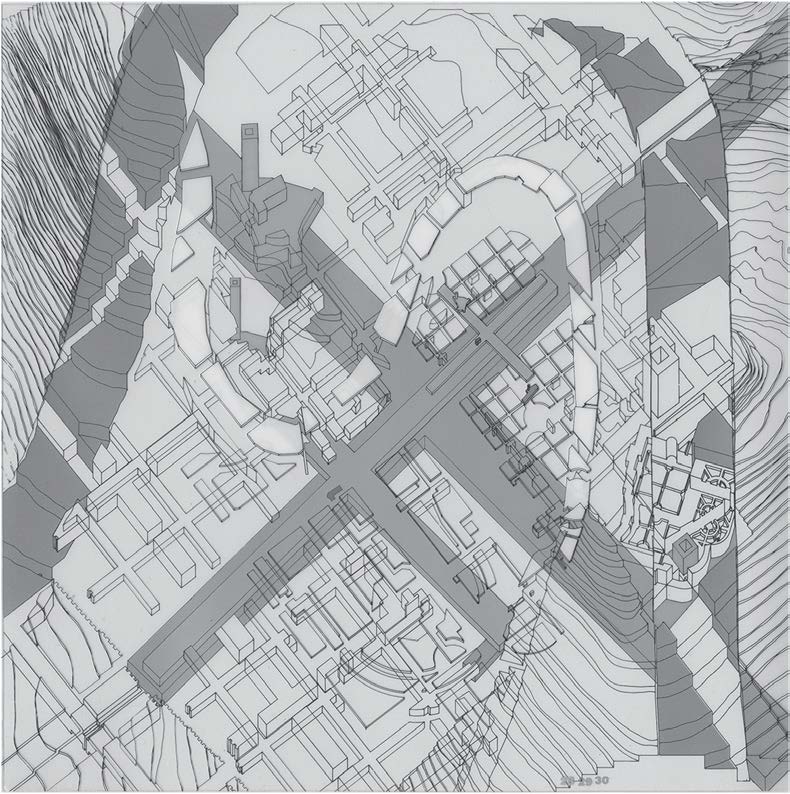
collage / Analogous City, Aldo Rossi, 1976 (https://dariorodighiero.com/Analogous-City)
axonometric / Moving Arrows, Eros and Other Erros, Peter Eisenman, 1986 (https://www.jstor.org/stable/29543520)
Consider a scale. Physically a scale is an object to measure other objects (i.e. a ruler). Architecturally, a scale is the relative size of a space or building that allows it to be categorized so (i.e. artifact, interior, building, urban, district, city, state, national, global, planetary). Representationally a scale a relative size to represent any content (i.e. 1:10, 1:50, 1:1000, 1’=1/8”, 1’=1/32”, and so on). In contrast, Moving Arrows manages to redefine the term semantically, and then play with it fictionally and representationally to draw multiple readings. Eisenman writes, “scaling is a method by which certain properties of an object (its plan structure, say) are selected or isolated from their context and transposed to a different location and represented at a different scale in juxtaposition with things in its new context (which need not necessarily have been rescaled or moved).”4 He finds meaning in a meaningless juxtaposition of the different definitions of scaling. The result is a representation of isolation, superimposition, and relationships to find new meanings in the physical geography, fictional narrative, and architectural speculation of Venice, Romeo and Juliet, and the project respectively. This historically and anthropomorphically detached, Moving Arrows, other than a cross-disciplinary representation, speculates multiple meaning and projects with different literary and representational permutations.
As a disciplinary counterpart, John Cage introduced the concept of ‘music by chance’. Inspired by I Ching, a Chinese classic text that defines a symbol system used to identify an order in chance events, Cage applied the same as a tool to compose music. One of the resulting and perhaps one of his most controversial compositions was the creation 4’33”. Pointing to the four minutes and thirty-three seconds duration, the composition was nothing but silence. In an interview Cage said:
“When I hear what we call music, it seems to me that someone is talking. And talking about his feelings or his ideas of relationships. But when I hear traffic, the sound of traffic—here on Sixth Avenue, for instance—I don’t have the feeling that anyone is talking. I have the feeling that the sound is acting. And I love the activity of sound ... I don’t need sound to talk to me.”5
John Cage in an interview with Miroslav Sebestik, 1991
John Cage left four minutes and thirty-three seconds silent for the audience to take notice of any other sound. Left open to the listener’s discretion, Cage speculated the use of other sounds to be a part of the compositions. Sounds that may not be entirely in his control and were uniquely experienced by each listener. Another similar speculation of chance was the constant tweaking of instrumentation to generate new sounds. His prepared piano that placed nuts, bolts, and rubber pieces in the piano graduated the composition from a solo piece in keys to a one with keys and a percussion ensemble. Not well-received due to the historical attunement to classical sounds, what Cage had done was simply challenge historical referencing and produced timeless pieces that were later picked up by multiple artists such as Nils Frahm in his composition Toilet Brushes6 where he interacts with the piano internally with different objects.
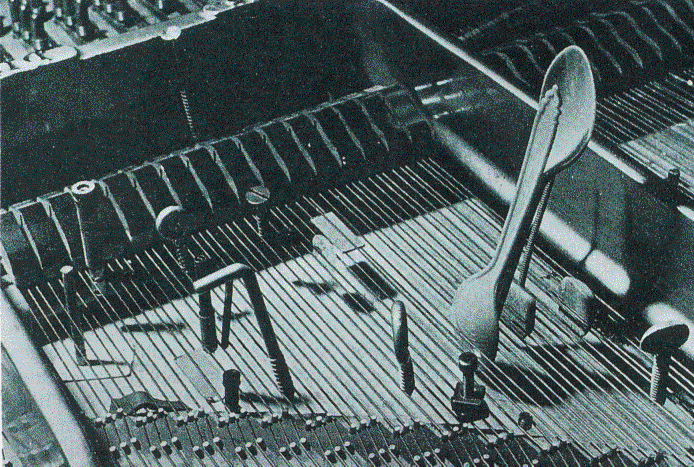
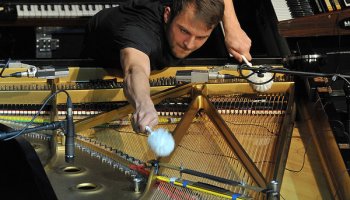
image / prepared piano by John Cagehttps://myycp.wordpress.com/2014/07/31/richard-aphex-john-cage-and-the-prepared-piano-robert-worby/
collage / Toilet Brushes performed by Nils Frahmhttps://www.youtube.com/results?search_query=nils+frahm+toilet+brushes
The open-ended semantic interpretation by the author and then eventually by the readers and listeners, in both cases, enables the work to gravitate beyond its original brief or intent. Pushing the work not just into an experimental space, it challenged both creator and reader to speculate alternatives beyond historical trends and popular nomenclature. The semantic reinterpretation of the semiotic recalibration pushes open work to not be an avant-garde piece but a tool to deploy more than just the work itself. Eisenman pushes Moving Arrows beyond a Venice Biennale entry to speculation in disciplinary interplay, the use, and reinvention of language in architecture, new modes of presentation, and new forms of reading. Similar to John Cage, the historical denial of Arnold Schoenberg, speculated beyond standard tonal trends to create a 12-tone technique as heard in his composition Opus 257, a years later Harry Partch speculated microtonality to develop his 43-tone piece.
In an architectural context, an open linguistic interpretation before and subsequently after creating a piece of work multiplies the scope for speculation. Cedric Price not only created a space of openwork in his Fun Palace, but he simultaneously reinterpreted the meaning of a theatre. Instead of a performer-viewer binary, he envisioned a space where both were embodied collectively where the user performs and views. Fictionally it relates to Shakespeare’s Seven Ages:
All the world’s a stage,
And all the men and women merely players;
They have their exits and their entrances,
And one man in his time plays many parts8
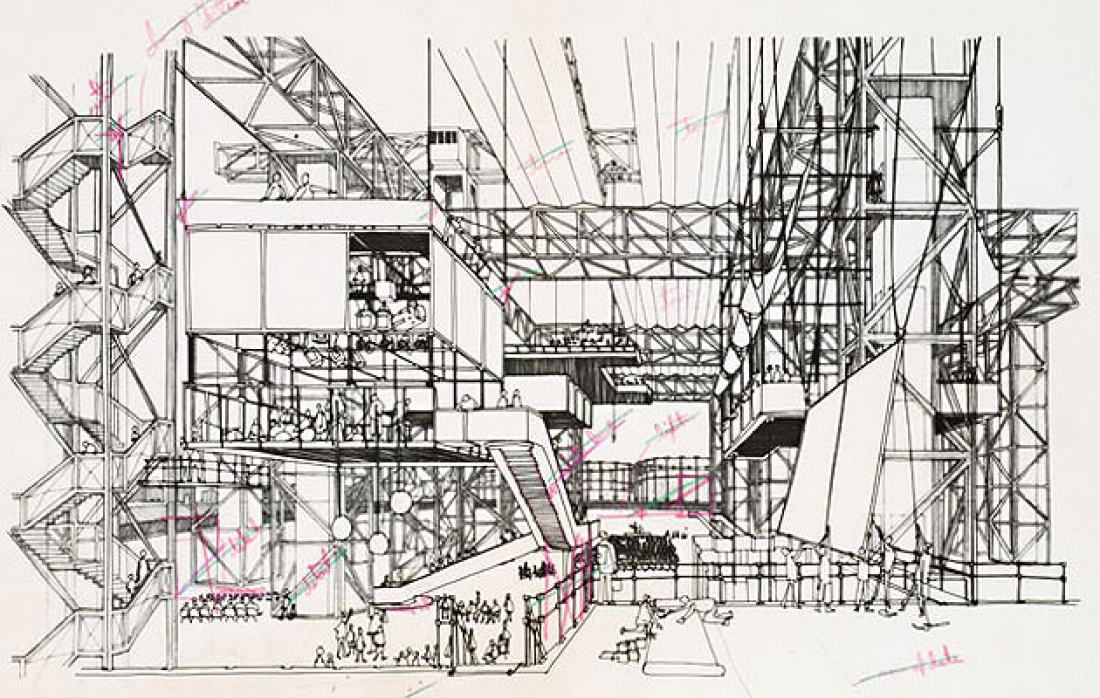
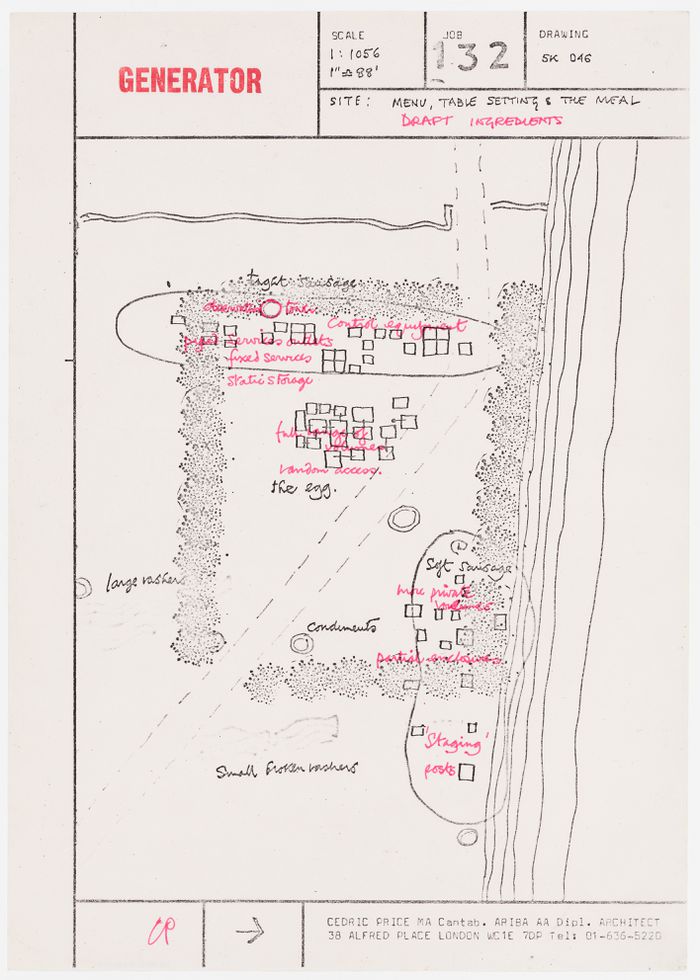

perspective / Fun Palace, Cedric Price, 1961https://www.metamute.org/editorial/articles/bowels-fun-palace
layout, sketches / Generator Project, Cedric Price, 1976-1979http://www.interactivearchitecture.org/the-generator-project.html
Price’s Generator project, though intrinsic to computing methodologies, challenged the creation, growth, and alteration of office space by speculating modes of choice and reading user needs. What may be project hara-kiri that time, has become the backbone of speculation in modular interior and building systems. It is the very backbone of Ikea and the works of contemporary architects like Chris Precht who push modular design and construction systems for high efficiency and low carbon footprint, simultaneously enabling new user needs.
In a world of highly definitive and detailed projects, open work of meaning and reading leaves room for projects to grow beyond a definitive scope. For Eisenman, the end of classicism marks the beginning of “timelessness that is no longer universal” whereby architectural design proceeds according to its internal disciplinary authority manifesting as notational acts of reading and writing.9 Overlooking the movements of classicism and post-modernism, it is the acts of reading and writing that flex the disciplinary muscle to think beyond the scope of the obvious and the speculate new reading, and in the case of Moving Arrows, misreadings. A moment of open-ended readings involves the receiver as a reader or interpreter, avoids a pedantic prescription by the author, and elevates the linearity of a piece of work to speculation.
×
References
1 _ Steven John Wilson and Andy Partridge, “Steven Wilson - To The Bone Lyrics | AZLyrics.com,” 2017, https://www.azlyrics.com/lyrics/stevenwilson/tothebone.html)
2 _ Umberto Eco, The Open Work, trans. Anna Cancogni (Cambridge: Harvard University Press, n.d.))
3 _ Aarati Kanekar, Architectures Pretexts: Spaces of Translation (London: Routledge, Taylor & Francis Group, 2015))
4 _ John Whiteman, “Notes on Architecture and the Concept of Fiction. Peter Eisenman: Moving Arrows, Eros and Other Errors,” AA Files, no. 12: pp. 76-84, accessed April 13, 2020, https://www.jstor.org/stable/29543520)
5 _ Listen: John Cage, in an Interview with Miroslav Sebestik. ARTE France Développement, 1991. https://www.youtube.com/watch?v=2aYT1Pwp30M.
6 _ YouTube (Erased Tapes, November 18, 2013), https://www.youtube.com/results?search_query=nils+frahm+toilet+brushes)
7 _ Schoenberg: Suite for Piano, Op.25 (Boffard). Youtube, 2016. https://www.youtube.com/watch?v=bQHR_Z8XVvI.
8 _ William Shakespeare, “The Seven Ages of Man,” Genius, accessed May 12, 2020, https://genius.com/William-shakespeare-the-seven-ages-of-man-all-the-worlds-a-stage-annotated)
9 _ Peter Eisenman, “The End of the Classical: The End of the Beginning, the End of the End,” Perspecta 21: pp. 154-173, accessed March 24, 2020, https://doi.org/10.2307/1567087)
︎